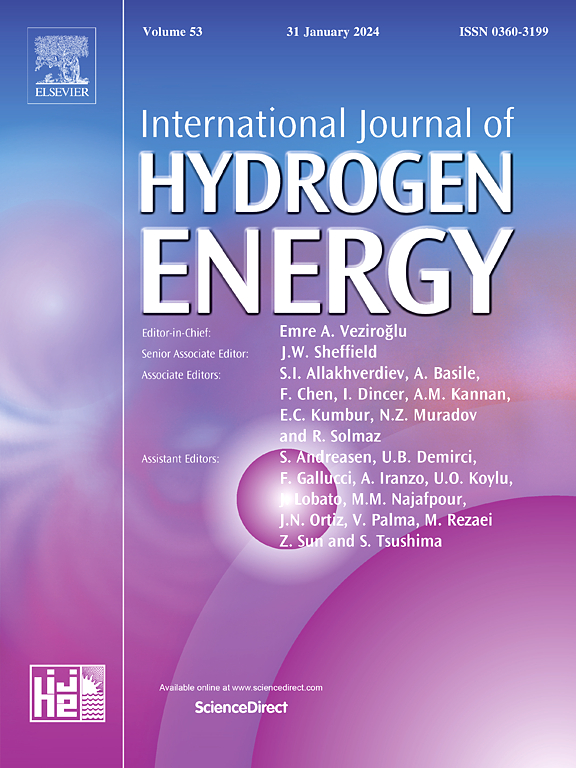rkiye横贯大陆氢气管道走廊设计的多准则层次分析法框架
IF 8.1
2区 工程技术
Q1 CHEMISTRY, PHYSICAL
引用次数: 0
摘要
本研究为多级氢气管道走廊的设计提供了一个全面且分析稳健的框架,以促进绿色氢气从能源丰富的亚洲向能源需求稳步增长的欧洲的洲际转移。在多指标决策的背景下,结合人口密度,采用层次分析法对能源生产潜力、能源消费潜力、可再生能源容量和产业发展四个主要指标进行了评价。这些标准的权重分别为55%、25%、6%和14%。建立了区域优先级,并通过bootstrap分析确保了统计稳健性,区域得分的置信区间为95%,区域间差异显著。城市的相互联系和相对贡献使用桑基图可视化,提供了供需动态的整体视图。基于情景的成本效益和成本绩效分析表明,在乐观假设下,一级走廊的效益/成本比为0.53,二级走廊为0.64,三级走廊为0.54。通过用绿色氢取代化石氢流,拟议中的HPC有可能每吨氢运输减少约5吨二氧化碳,为欧洲的脱碳努力做出重大贡献。此外,在乐观的情况下,该走廊预计将产生高达18亿欧元的年收入,增强供应多样化,并利用本文章由计算机程序翻译,如有差异,请以英文原文为准。
A multi-criteria analytical hierarchy process framework for the design of Türkiye's transcontinental hydrogen pipeline corridor
This study presents a comprehensive and analytically robust framework for the design of a multi-stage Hydrogen Pipeline Corridor to facilitate the intercontinental transfer of green hydrogen from energy-rich Asia to Europe, where energy demand is steadily increasing. Within the context of multi-criteria decision-making, the Analytical Hierarchy Process was employed to evaluate four main criteria: energy production potential, energy consumption potential, renewable energy capacity, and industrial development combined with population density. The respective weights of these criteria were calculated as 55 %, 25 %, 6 %, and 14 %. Regional priorities were established, and statistical robustness was ensured through bootstrap analysis, yielding 95 % confidence intervals for regional scores and revealing significant differences among regions. The interconnections and relative contributions of cities were visualized using a Sankey diagram, providing a holistic view of supply-demand dynamics. Scenario-based cost–benefit and cost–performance analyses indicate that, under optimistic assumptions, the benefit/cost ratios reach 0.53 for the primary corridor, 0.64 for the secondary corridor, and 0.54 for the tertiary corridor. By replacing fossil-based hydrogen flows with green hydrogen, the proposed HPC has the potential to abate approximately 5 tCO2 per tonne of hydrogen transported, contributing significantly to Europe's decarbonization efforts. Furthermore, the corridor is projected to generate annual revenues up to 1.8 billion € under optimistic scenarios, enhancing supply diversification and leveraging Türkiye's unique transcontinental position as a strategic energy bridge. These findings offer actionable insights for policymakers and investors, supporting the feasibility and scalability of large-scale hydrogen infrastructure planning in Türkiye and the broader region.
求助全文
通过发布文献求助,成功后即可免费获取论文全文。
去求助
来源期刊

International Journal of Hydrogen Energy
工程技术-环境科学
CiteScore
13.50
自引率
25.00%
发文量
3502
审稿时长
60 days
期刊介绍:
The objective of the International Journal of Hydrogen Energy is to facilitate the exchange of new ideas, technological advancements, and research findings in the field of Hydrogen Energy among scientists and engineers worldwide. This journal showcases original research, both analytical and experimental, covering various aspects of Hydrogen Energy. These include production, storage, transmission, utilization, enabling technologies, environmental impact, economic considerations, and global perspectives on hydrogen and its carriers such as NH3, CH4, alcohols, etc.
The utilization aspect encompasses various methods such as thermochemical (combustion), photochemical, electrochemical (fuel cells), and nuclear conversion of hydrogen, hydrogen isotopes, and hydrogen carriers into thermal, mechanical, and electrical energies. The applications of these energies can be found in transportation (including aerospace), industrial, commercial, and residential sectors.
 求助内容:
求助内容: 应助结果提醒方式:
应助结果提醒方式:


